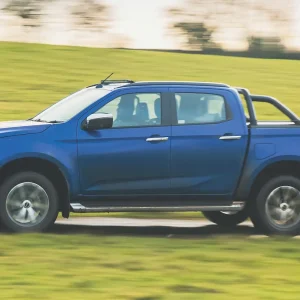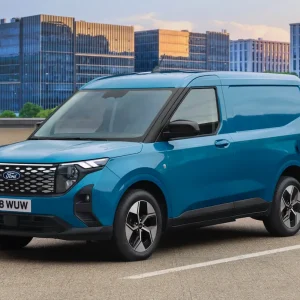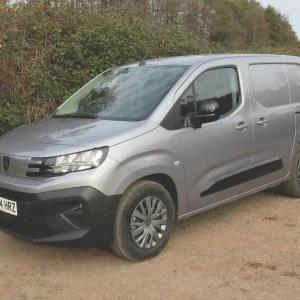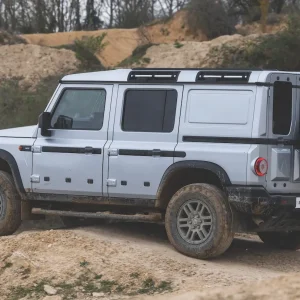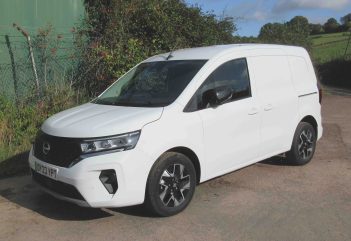
Nissan is embracing the zero-emission gospel with gusto.
Based around sister brand Renault’s Kangoo, its Townstar van is admittedly available with petrol power. There is no diesel option however, and Nissan is eagerly promoting the battery-electric EV version as the successor to its successful e-NV200.
Like the Kangoo, the Townstar EV comes with a 90kW electric motor. Two versions are up for grabs – the short-wheelbase L1 with a 3.3m3 load area and the long-wheelbase L2 with a 4.3m3 load area – and as usual Nissan is offering a wide choice of specifications.
Customers can opt for entry-level Visia with an 11kW AC onboard charger or progress up through Acenta, Tekna and top-of-the-range Tekna+. All three of these options feature a 22kW AC/80kW DC onboard charger.
The L2 variant is additionally marketed as a crew van, in Tekna trim only.
Significantly cheaper than its electric stablemate and able to carry up to 189kg more, the petrol TCe van is equipped with a 130hp 1.3-litre engine married to a six-speed gearbox. It is on sale in L1 and L2 guise and with all four of the aforementioned trims, but is not offered as a crew van.
Don’t forget that the Kangoo and Townstar are also marked by Mercedes-Benz under the Citan banner.
Conscious of our environmental responsibilities, we went for a Townstar EV L1 van in Tekna+ guise. Here’s how we fared.
Load bay
The dinky fold-down rear-view mirror fitted in the cab seems a mite pointless given that the full-height bulkhead that divides the cab from the cargo area is opaque. It is plastic too, presumably in a bid to save a bit of weight, and although we tend to favour a steel bulkhead, it seems robust enough.
The twin rear doors are opaque, too. They are asymmetric, with the narrower of the two on the offside, and can be swung through 90°, or through 180° if you release the stays.
A sliding door is installed on both sides of the load bay, which comes with eight tie-down points; six set into the floor plus one on each of the sidewalls, about half-way up and close to the rear door pillars.
Our demonstrator’s cargo bed was protected by a wooden cover with most of the rest of the load area reasonably well defended against scrapes and scratches by a mixture of timber and plastic panels.
Interior and equipment
At the centre of the Tekna+’s dashboard is an 8in touchscreen that controls a number of the van’s key functions, including its satellite navigation system. A DAB radio is provided with remote controls on the steering wheel along with Android Auto, Apple CarPlay and Bluetooth connectivity.
Good to see though that the heating and ventilation system and the air-conditioning are controlled by chunky, user-friendly knobs mounted just below the screen; makes life a lot easier if all you want to do is turn the temperature in the cabin up a notch and don’t want to spend time prodding a screen.
Tekna+ comes with keyless entry and ignition and an electronic parking brake. Also included in the deal are front, rear and side parking sensors and front and rear-facing safety cameras, with a birds-eye view that shows how close you are to a potential obstacle.
You can alter the bird’s-eye setting to allow you to see exactly what is happening in the van’s nearside blind-spot; a valuable safety aid.
Other features include a driver’s airbag, electric windows, heated and power-operated exterior mirrors that fold in electrically and a smartphone holder. An instrument panel display tells you how much charge is left in the battery and the range you have available.
The heated leather-trimmed steering wheel is height-adjustable, as is the driver’s seat.
In-cab storage facilities are plentiful. They include a capacious lidded box between the front seats along with a pair of big cup-holders, shelves above the windscreen, bins in the doors, a roomy glovebox and a lidded compartment above the instrument panel that contains a pair of USB sockets and a 12v power point. You will find another 12v point in a tray at the bottom of the dashboard.
Tekna+ comes with all the usual safety systems found on a modern van in a package which includes ProPilot.
Designed to be of help if you are travelling down a stretch of motorway or dual carriageway, it includes intelligent adaptive cruise control that should keep you a safe distance from the vehicle in front.
Featured too are lane departure warning and lane keeping assist. They are designed to prevent you from lazily drifting out of the lane you are supposed to be in, and potentially into the path of another vehicle.
Over and above ProPilot, Intelligent Brake Assist is installed as well. It alerts you if you are getting too close to the driver in front, and applies the brakes if you ignore the warning.
Blind Spot Detection with Intervention Assistance is present too. It detects vehicles in your blind spot and triggers an audible and visual alert, applying the brakes if necessary.
Hill Hold Assist is there to prevent you from rolling backwards if you are moving away from rest on an incline, Driver Attention Alert kicks off if it thinks you are tired and losing concentration, and Traffic Sign Recognition is present as well. It flags up the speed limit on the road you are travelling down.
Traction Control System is fitted, and can be switched off if necessary.
The wipers trigger automatically when raindrops start spattering across the windscreen and the headlights illuminate automatically at dusk.
Our test van’s 16in alloy wheels were shod with Continental EcoContact 205/60 R16 tyres. They are covered by a pressure monitoring system.
We spotted a Parking Assist button and it would be interesting to see how many van drivers press it. Doing so will initiate technology which will help guide them into a parking space.
Bear in mind that you can communicate with the Townstar EV with your smartphone by means of the NissanConnect Services App. By using it you can for example find out where your vehicle is parked and control the cabin temperature remotely.
Powertrain
Generating up to 245Nm of torque, and married to a single-speed automatic transmission, the electric motor draws power from a 45kWh lithium-ion battery. The battery charging point is at the front of the vehicle, beneath the Nissan logo.
Driving
No matter whether you are laden or unladen, the Townstar EV rides surprisingly well, possibly because the weight of the battery pack prevents it from bouncing around too much. It handles well too, although there were times when we felt the steering could stand to be tightened a little to deliver better response and more feedback as we launched ourselves into bends.
Performance is not an issue.
Even if you press a button on the dashboard to switch to the Eco setting in a bid to preserve the vehicle’s range between recharges, you will find acceleration and the van’s ability to cruise at speed along motorways and dual-carriageways will not suffer unduly. We used the Eco setting with a 300kg test load onboard and took the Townstar EV up and down the hills of Herefordshire and Gloucestershire, and did not feel we were being held back.
The absence of decibels from an internal combustion engine does however mean that all the other sources of noise are highlighted. Wind and tyre noise are undoubtedly noticeable.
Something you can certainly hear at low speeds from inside the vehicle is the white noise the van generates to alert pedestrians and other vulnerable road users to its presence.
Tap the transmission lever to the right and you can select from three different levels of regeneration – B1, B2, or B3, the most aggressive – which recapture energy that would otherwise be wasted, and pump it into the battery.
Driving the Townstar EV predominantly in a rural area we found B1 the most useful, even though it is the mildest. It recoups energy when you descend a hill and take your foot off the accelerator, but without slowing you down unduly.
That said, we can certainly appreciate the benefits likely to be delivered by B2 and B3 in an urban setting.
While Nissan quotes a WLTP (Worldwide Harmonised Light Vehicle Test Procedure) combined range of 176 miles for the Tekna+ between recharges assuming the battery is fully-charged to begin with, cold weather can reduce the projected range significantly; a concern with every electric van we have encountered. A sudden fall in temperature cut our van’s projected range to 137 miles, even though the battery was charged to the maximum.
On the positive side the Tekna+ can be charged up quickly, with a battery that can get from 15% to 80% in an hour-and-a-half says Nissan. Plug it into a fast charger and it should be able to reach 80% of its charging capacity from 15% to begin with in no more than 37 minutes, Nissan contends.
Those figures apply if you are using public charging points. Plug your van into a 7.3kW domestic wall-box and you should be able to go from 0% to 100% in seven hours.
If range is a vital consideration then it is perhaps worth noting that the manufacturer quotes a combined range of 182 miles for the less-well-equipped Visia variant.
Operating
The Townstar EV is protected by a five-year/100,000-mile warranty with roadside assistance provided for the duration. The battery is covered by an eight-year/100,000-mile warranty which reacts if its charging capacity drops below 70%.
If that happens then the battery is either repaired or replaced, as appropriate.
Service intervals are set at two years/24,000 miles.
The use of long-lasting LEDs in the front fog lights, headlights, daytime running, side indicator and load area lights should help keep maintenance costs down. However the absence of side rubbing strips on the exterior of the van could result in it collecting rather too many scrapes and minor dents.
No spare wheel is provided, alas, in another bid to save weight. You get an inflator/sealer instead; not a lot of help if your tyre suffers really serious damage courtesy of one of the UK’s innumerable deep potholes.
Nissan Townstar EV L1 Tekna +
Price (ex VAT) £37,345**
Price range (ex VAT) £32,445–38,545**
Gross payload 500kg
Load length 1810mm
Load width (min/max) 1,248mm/1,570mm
Load bay height 1,215mm
Load volume 3.3m3
Loading height 634mm
Rear door aperture 1,256mm x 1,115mm
Side door aperture 615mm x 1,060mm
Gross vehicle weight 2,220kg
Braked/unbraked trailer towing weight 750kg/1,500kg
Residual value 28.4%
Cost per mile 60.5p
Engine size/power (electric motor) 90kW (122hp)
Torque 245Nm
Gearbox 1sp
Range (WLTP combined) 176mls
Battery 45kWh
Warranty 5yrs/100,000mls (battery 8yrs/100,000mls)
Service intervals 2yrs/24,000mls
Insurance group TBA
Price as tested £37,345
* After 48 months/20,000mls p.a – source – KWIKcarcost
** Basic price before VAT, On The Road costs, and government Plug-in Van Grant
Maxus eDeliver 3
Price range (ex VAT) from £34,000**
Load volume 4.8m3
Gross payload 865-905kg
Electric motor 90kW (122hp)
Verdict: Larger than the Townstar EV, the eDeliver 3 is marketed as a chassis cab as well as in panel van guise.. Maxus gets full marks for offering customers the choice of two different battery packs. We’ve no reason to suppose that the 200-mile-plus range predictions made by the manufacturer are inaccurate, and the eDeliver 3 is certainly worth investigating if you need more space and payload capacity than the Townstar EV offers.
Peugeot e-Partner
Price range (ex VAT) £32,385–34,840**
Load volume 3.3-3.8m3
Gross payload 751-803kg
Electric motor 100kW (134hp)
Verdict: It remains a sensible choice, with a decent payload capacity. Don’t forget that the same model is marketed by Citroën as the e-Berlingo, by Fiat Professional as the E-Doblo,and by Vauxhall as the Combo-e. All four have just undergone a revamp as part of owner Stellantis’s Pro One light commercial strategy, with longer ranges promised. Remember that the same model is offered by Toyota as the Proace City Electric, and Toyota’s warranty package is especially impressive.
Volkswagen ID.Buzz Cargo
Price range (ex VAT) £39,625–43,875**
Load volume 3.9m3
Gross payload 592-607kg
Electric motor 150kW (201hp)
Verdict: Precious few vans can be said to be unique in styling terms, but this one certainly is. It boasts plenty of power and a claimed range of over 250 miles, but the front-end price is eye-wateringly steep and payload capacity is disappointingly modest. Plenty of emphasis is placed on safety though, which we can only welcome. Shame VW has no plans to introduce a long-wheelbase variant.
The Final Verdict
Design 8/10 – Carefully crafted to appeal to businesses in need of a zero-emission urban/suburban runabout
Cabin 8/10 – A comfortable, well-specified, working environment
Ride 8/10 – Smoother than we expected no matter whether we were laden or unladen
Refinement 7/10 – Absence of an engine means that other sources of noise become more intrusive.
Load area 7/10 – Good access from three sides, but loses out so far as payload is concerned
Handling/performance 7/10 – Latter is to a high standard, former could be improved by making the steering more responsive
Engine/transmission 7/10 – Battery can be charged up rapidly, but as usual the range falls just as soon as the outside temperature drops
Standard equipment 8/10 – Lots of useful kit is included in the deal, with an admirable stress on safety
Operating costs 8/10 – A comprehensive warranty should help keep expenditure down
What Van? subjective rating 8/10 – A well-thought-out package that includes some intelligent ideas
Overall Rating = 76/100

